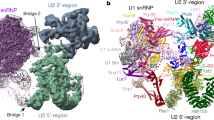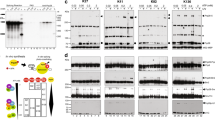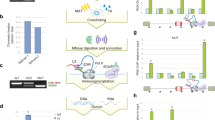Abstract
To produce messenger RNA, the spliceosome excises introns from precursor (pre)-mRNA and splices the flanking exons. To establish fidelity, the spliceosome discriminates against aberrant introns, but current understanding of such fidelity mechanisms is limited. Here we show that an ATP-dependent activity represses formation of mRNA from aberrant intermediates having mutations in any of the intronic consensus sequences. This proofreading activity is disabled by mutations that impair the ATPase or RNA unwindase activity of Prp22p, a conserved spliceosomal DExD/H-box ATPase. Further, cold-sensitive prp22 mutants permit aberrant mRNA formation from a mutated 3′ splice-site intermediate in vivo. We conclude that Prp22p generally represses splicing of aberrant intermediates, in addition to its known ATP-dependent role in promoting release of genuine mRNA. This dual function for Prp22p validates a general model in which fidelity can be enhanced by a DExD/H-box ATPase.
This is a preview of subscription content, access via your institution
Access options
Subscribe to this journal
Receive 12 print issues and online access
$189.00 per year
only $15.75 per issue
Buy this article
- Purchase on Springer Link
- Instant access to full article PDF
Prices may be subject to local taxes which are calculated during checkout




Similar content being viewed by others
References
Will, C.L. & Lührmann, R. Spliceosome structure and function. in The RNA World 3rd edn. (eds. Gesteland, R.F., Cech, T.R. & Atkins, J.F.) 369–400 (Cold Spring Harbor Laboratory Press, New York, 2006).
Valadkhan, S. snRNAs as the catalysts of pre-mRNA splicing. Curr. Opin. Chem. Biol. 9, 603–608 (2005).
Staley, J.P. & Guthrie, C. Mechanical devices of the spliceosome: motors, clocks, springs, and things. Cell 92, 315–326 (1998).
Cordin, O., Banroques, J., Tanner, N.K. & Linder, P. The DEAD-box protein family of RNA helicases. Gene 367, 17–37 (2005).
Burgess, S.M. & Guthrie, C. A mechanism to enhance mRNA splicing fidelity: the RNA-dependent ATPase Prp16 governs usage of a discard pathway for aberrant lariat intermediates. Cell 73, 1377–1391 (1993).
Schwer, B. & Guthrie, C. A conformational rearrangement in the spliceosome is dependent on PRP16 and ATP hydrolysis. EMBO J. 11, 5033–5039 (1992).
Burgess, S.M. & Guthrie, C. Beat the clock: paradigms for NTPases in the maintenance of biological fidelity. Trends Biochem. Sci. 18, 381–384 (1993).
Hopfield, J.J. Kinetic proofreading: a new mechanism for reducing errors in biosynthetic processes requiring high specificity. Proc. Natl. Acad. Sci. USA 71, 4135–4139 (1974).
Yarus, M. Proofreading, NTPases and translation: constraints on accurate biochemistry. Trends Biochem. Sci. 17, 130–133 (1992).
Newman, A.J. & Norman, C. U5 snRNA interacts with exon sequences at 5′ and 3′ splice sites. Cell 68, 743–754 (1992).
Lesser, C.F. & Guthrie, C. Mutations in U6 snRNA that alter splice site specificity: implications for the active site. Science 262, 1982–1988 (1993).
Madhani, H.D. & Guthrie, C. Randomization-selection analysis of snRNAs in vivo: evidence for a tertiary interaction in the spliceosome. Genes Dev. 8, 1071–1086 (1994).
Umen, J.G. & Guthrie, C. Mutagenesis of the yeast gene PRP8 reveals domains governing the specificity and fidelity of 3′ splice site selection. Genetics 143, 723–739 (1996).
Collins, C.A. & Guthrie, C. Allele-specific genetic interactions between Prp8 and RNA active site residues suggest a function for Prp8 at the catalytic core of the spliceosome. Genes Dev. 13, 1970–1982 (1999).
Chang, J.S. & McPheeters, D.S. Identification of a U2/U6 helix la mutant that influences 3′ splice site selection during nuclear pre-mRNA splicing. RNA 6, 1120–1130 (2000).
Ben-Yehuda, S., Russell, C.S., Dix, I., Beggs, J.D. & Kupiec, M. Extensive genetic interactions between PRP8 and PRP17/CDC40, two yeast genes involved in pre-mRNA splicing and cell cycle progression. Genetics 154, 61–71 (2000).
Dagher, S.F. & Fu, X.-D. Evidence for a role of Sky1p-mediated phosphorylation in 3′ splice site recognition involving both Prp8 and Prp17/Slu4. RNA 7, 1284–1297 (2001).
Query, C.C. & Konarska, M.M. Suppression of multiple substrate mutations by spliceosomal prp8 alleles suggests functional correlations with ribosomal ambiguity mutants. Mol. Cell 14, 343–354 (2004).
Villa, T. & Guthrie, C. The Isy1p component of the NineTeen Complex interacts with the ATPase Prp16p to regulate the fidelity of pre-mRNA splicing. Genes Dev. 19, 1894–1904 (2005).
Konarska, M.M. & Query, C.C. Insights into the mechanisms of splicing: more lessons from the ribosome. Genes Dev. 19, 2255–2260 (2005).
Vijayraghavan, U. et al. Mutations in conserved intron sequences affect multiple steps in the yeast splicing pathway, particularly assembly of the spliceosome. EMBO J. 5, 1683–1695 (1986).
Rymond, B.C. & Rosbash, M. Cleavage of 5′ splice site and lariat formation are independent of 3′ splice site in yeast mRNA splicing. Nature 317, 735–737 (1985).
Reed, R. The organization of 3′ splice-site sequences in mammalian introns. Genes Dev. 3, 2113–2123 (1989).
Fouser, L.A. & Friesen, J.D. Effects on mRNA splicing of mutations in the 3′ region of the Saccharomyces cerevisiae actin intron. Mol. Cell. Biol. 7, 225–230 (1987).
Luukkonen, B.G. & Séraphin, B. The role of branchpoint-3′ splice site spacing and interaction between intron terminal nucleotides in 3′ splice site selection in Saccharomyces cerevisiae. EMBO J. 16, 779–792 (1997).
Konarska, M.M., Vilardell, J. & Query, C.C. Repositioning of the reaction intermediate within the catalytic center of the spliceosome. Mol. Cell 21, 543–553 (2006).
Frank, D. & Guthrie, C. An essential splicing factor, SLU7, mediates 3′ splice site choice in yeast. Genes Dev. 6, 2112–2124 (1992).
Chua, K. & Reed, R. The RNA splicing factor hSlu7 is required for correct 3′ splice-site choice. Nature 402, 207–210 (1999).
Wagner, J.D., Jankowsky, E., Company, M., Pyle, A.M. & Abelson, J.N. The DEAH-box protein PRP22 is an ATPase that mediates ATP-dependent mRNA release from the spliceosome and unwinds RNA duplexes. EMBO J. 17, 2926–2937 (1998).
Schwer, B. & Gross, C.H. Prp22, a DExH-box RNA helicase, plays two distinct roles in yeast pre-mRNA splicing. EMBO J. 17, 2086–2094 (1998).
Bousquet-Antonelli, C., Presutti, C. & Tollervey, D. Identification of a regulated pathway for nuclear pre-mRNA turnover. Cell 102, 765–775 (2000).
Hilleren, P.J. & Parker, R. Cytoplasmic degradation of splice-defective pre-mRNAs and intermediates. Mol. Cell 12, 1453–1465 (2003).
Aroian, R.V. et al. Splicing in Caenorhabditis elegans does not require an AG at the 3′ splice acceptor site. Mol. Cell. Biol. 13, 626–637 (1993).
Dominski, Z. & Kole, R. Identification and characterization by antisense oligonucleotides of exon and intron sequences required for splicing. Mol. Cell. Biol. 14, 7445–7454 (1994).
Frilander, M.J. & Steitz, J.A. Dynamic exchanges of RNA interactions leading to catalytic core formation in the U12-dependent spliceosome. Mol. Cell 7, 217–226 (2001).
Lingner, J. & Cech, T.R. Purification of telomerase from Euplotes aediculatus: requirement of a primer 3′ overhang. Proc. Natl. Acad. Sci. USA 93, 10712–10717 (1996).
Kim, S.H., Smith, J., Claude, A. & Lin, R.-J. The purified yeast pre-mRNA splicing factor PRP2 is an RNA-dependent NTPase. EMBO J. 11, 2319–2326 (1992).
Tanaka, N. & Schwer, B. Characterization of the NTPase, RNA-binding, and RNA helicase activities of the DEAH-box splicing factor Prp22. Biochemistry 44, 9795–9803 (2005).
McPheeters, D.S. & Muhlenkamp, P. Spatial organization of protein-RNA interactions in the branch site-3′ splice site region during pre-mRNA splicing in yeast. Mol. Cell. Biol. 23, 4174–4186 (2003).
Horowitz, D.S. & Abelson, J. Stages in the second reaction of pre-mRNA splicing: the final step is ATP independent. Genes Dev. 7, 320–329 (1993).
James, S.A., Turner, W. & Schwer, B. How Slu7 and Prp18 cooperate in the second step of yeast pre-mRNA splicing. RNA 8, 1068–1077 (2002).
Schwer, B. & Meszaros, T. RNA helicase dynamics in pre-mRNA splicing. EMBO J. 19, 6582–6591 (2000).
Schneider, S., Hotz, H.R. & Schwer, B. Characterization of dominant-negative mutants of the DEAH-box splicing factors Prp22 and Prp16. J. Biol. Chem. 277, 15452–15458 (2002).
Schneider, S., Campodonico, E. & Schwer, B. Motifs IV and V in the DEAH box splicing factor Prp22 are important for RNA unwinding, and helicase-defective Prp22 mutants are suppressed by Prp8. J. Biol. Chem. 279, 8617–8626 (2004).
Martin, A., Schneider, S. & Schwer, B. Prp43 is an essential RNA-dependent ATPase required for release of lariat-intron from the spliceosome. J. Biol. Chem. 277, 17743–17750 (2002).
Arenas, J.E. & Abelson, J.N. Prp43: An RNA helicase-like factor involved in spliceosome disassembly. Proc. Natl. Acad. Sci. USA 94, 11798–11802 (1997).
Leeds, N.B., Small, E.C., Hiley, S.L., Hughes, T.R. & Staley, J.P. The splicing factor Prp43p, a DEAH box ATPase, functions in ribosome biogenesis. Mol. Cell. Biol. 26, 513–522 (2006).
Lesser, C.F. & Guthrie, C. Mutational analysis of pre-mRNA splicing in Saccharomyces cerevisiae using a sensitive new reporter gene, CUP1. Genetics 133, 851–863 (1993).
Fouser, L.A. & Friesen, J.D. Mutations in a yeast intron demonstrate the importance of specific conserved nucleotides for the two stages of nuclear mRNA splicing. Cell 45, 81–93 (1986).
Query, C.C., Strobel, S.A. & Sharp, P.A. Three recognition events at the branch-site adenine. EMBO J. 15, 1392–1402 (1996).
Parker, R. & Siliciano, P.G. Evidence for an essential non-Watson-Crick interaction between the first and last nucleotides of a nuclear pre-mRNA intron. Nature 361, 660–662 (1993).
Campodonico, E. & Schwer, B. ATP-dependent remodeling of the spliceosome: intragenic suppressors of release-defective mutants of Saccharomyces cerevisiae Prp22. Genetics 160, 407–415 (2002).
Ohno, M. & Shimura, Y. A human RNA helicase-like protein, HRH1, facilitates nuclear export of spliced mRNA by releasing the RNA from the spliceosome. Genes Dev. 10, 997–1007 (1996).
van Nues, R.W. & Beggs, J.D. Functional contacts with a range of splicing proteins suggest a central role for Brr2p in the dynamic control of the order of events in spliceosomes of Saccharomyces cerevisiae. Genetics 157, 1451–1467 (2001).
Cochella, L. & Green, R. Fidelity in protein synthesis. Curr. Biol. 15, R536–R540 (2005).
Mohr, S., Stryker, J.M. & Lambowitz, A.M. A DEAD-box protein functions as an ATP-dependent RNA chaperone in group I intron splicing. Cell 109, 769–779 (2002).
Ballut, L. et al. The exon junction core complex is locked onto RNA by inhibition of eIF4AIII ATPase activity. Nat. Struct. Mol. Biol. 12, 861–869 (2005).
Brys, A. & Schwer, B. Requirement for SLU7 in yeast pre-mRNA splicing is dictated by the distance between the branchpoint and the 3′ splice site. RNA 2, 707–717 (1996).
Stevens, S.W. & Abelson, J. Yeast pre-mRNA splicing: methods, mechanisms, and machinery. Methods Enzymol. 351, 200–220 (2002).
Rigaut, G. et al. A generic protein purification method for protein complex characterization and proteome exploration. Nat. Biotechnol. 17, 1030–1032 (1999).
Acknowledgements
We thank S.-C. Cheng (Academia Sinica) for the gift of antibodies to Ntc20; D. Bishop, L. Cochella, B. Glick, R. Green, J. Piccirilli, H. Singh, E. Sontheimer and members of the Staley laboratory for critical reading of the manuscript; and C. Jordan, V. Shaw and M. Norman for technical assistance. This research was supported by a predoctoral fellowship from the Ford Foundation to R.M.M. and by grants from the US National Institutes of Health and the Packard Foundation to J.P.S.
Author information
Authors and Affiliations
Corresponding author
Ethics declarations
Competing interests
The authors declare no competing financial interests.
Supplementary information
Supplementary Fig. 1
A prp43 mutant does not permit exon ligation at an aberrant 3′ splice site (PDF 721 kb)
Supplementary Methods
Oligonucleotides, plasmids, strains and RT-PCR (PDF 106 kb)
Rights and permissions
About this article
Cite this article
Mayas, R., Maita, H. & Staley, J. Exon ligation is proofread by the DExD/H-box ATPase Prp22p. Nat Struct Mol Biol 13, 482–490 (2006). https://doi.org/10.1038/nsmb1093
Received:
Accepted:
Published:
Issue Date:
DOI: https://doi.org/10.1038/nsmb1093
This article is cited by
-
psiCLIP reveals dynamic RNA binding by DEAH-box helicases before and after exon ligation
Nature Communications (2021)
-
Cryo-electron microscopy snapshots of the spliceosome: structural insights into a dynamic ribonucleoprotein machine
Nature Structural & Molecular Biology (2017)
-
A temperature-sensitive allele of a putative mRNA splicing helicase down-regulates many cell wall genes and causes radial swelling in Arabidopsis thaliana
Plant Molecular Biology (2016)
-
Functional roles of DExD/H-box RNA helicases in Pre-mRNA splicing
Journal of Biomedical Science (2015)
-
Single Molecule Cluster Analysis dissects splicing pathway conformational dynamics
Nature Methods (2015)




